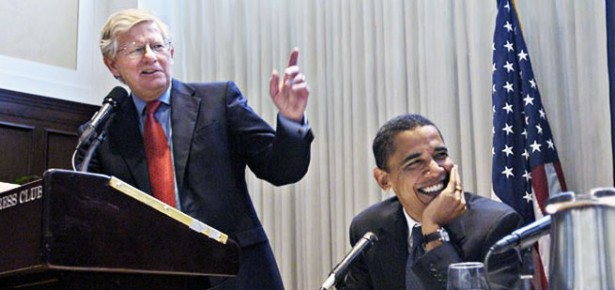
James Thurber with President Obama.
Congress has ceased to operate as an effective legislative body, with deliberation and compromise being supplanted by conflict and gridlock. It continues tribal warfare, especially in the 2016 election cycle.
While the causes are complex, some of following factors have helped establish congressional gridlock as the norm in Congress and in state legislatures:
• A highly partisan and polarized electorate
• Sorting of the population both geographical and ideologically
• Redistricting an increasing number of safe seats (more on that in this video)
• Regional realignment of the Confederate South
• Constitutional arrangements (separation of power and bicameralism)
• Divided party government
• Polarization of interest groups leading to “hyper-pluralism” and stalemate
These trends that have led political polarization among government institutions are discussed in our (co-edited with Antoine Yoshinaka) recent edited volume, American Gridlock: The Sources, Character, and Impact of Political Polarization.
One of the most visible features of our democracy that we describe in the book is the partisan electorate. Representatives in Congress respond more to their activist bases than to the median voter in the general election. This “force for polarization” means that both independent voters and members who reach across the aisle and compromise are nearly extinct.
The electorate’s growing partisan nature has coincided with a high degree of consistency in the results of recent elections. The 2012 presidential election saw the highest party loyalty in the history of the American National Election Study (conducted since 1948): 93% of Democrats voted for Obama and 93% of Republicans voted for Romney. The 2012 election also produced the lowest rate of ticket splitting, as 90% of Americans supported the same party for president and the House, 89% for president and the Senate, and 87% for the House and the Senate.
Voters are less inclined to support a centrist candidate than ever before and the widening gap is staggering as shown in the battle for the presidential nomination in 2016. Candidates have more reason to appeal to their extreme supporters than to try to win independent voters as a pragmatic moderate.
Many states and congressional districts are experiencing greater one-party domination as racial, ideological, and cultural lines divide voters into buckets. In many cases, they are also redrawn into districts that make incumbents safer and safer. In the 1960s and early 1970s, there was plenty of cross-party cooperation. Roughly one-third of members in the House and Senate were moderates voting together. Now four percent vote together in the middle. From the early 1980s to present, every year we’ve lost more and more people voting together, and fewer and fewer competitive [congressional] races in the general election.
A prime-motivating factor for this transition was the dwindling number of conservative Southern Democrats and Blue Dogs (moderate Democrats). The entire South became reliably Republican, and the blueprint for the eventual “red” and blue” America was born. Though this process started in the 1960s with Democratic President Lyndon Johnson’s embrace of civil rights and voting rights legislation, it hadn’t neared completion until much more recently.
Just to put it in perspective: In 2008, we had 58 [moderate-to-conservative Blue Dog Democrats], and now, if they’re willing to admit it, there are six Democrats in that category. And there are no “moderate” or “liberal” Republicans. “Establishment Republicans” has even become a negative term to the right of the Republican Party.
Partisanship in Congress has stifled the budgetary and appropriations processes. Partisan battles over the federal budget and spending bills over the last 20 years are a prime example of the fundamental policy differences between the parties. Bipartisanship is rare if not nonexistent in Washington when it comes to tax increases and cuts in popular domestic social programs. Both are needed to reduce the deficit and the debt, but the parties have taken increasingly extreme positions on their willingness to compromise on taxes and means testing in social programs.
The 114th Congress deserves some credit for what some have called “an improved legislative process” under House Speaker Ryan and this might signal a return to the regular order and some bipartisanship. There remains work to be done.
There is always hope, but the 2016 election campaign does not bode well for the future of polarization and governing.
The combination of “wedge issues” (e.g. heath policy, immigration and gun control) and massive amounts of campaign money supporting extreme positions (especially on the right) that appeal to the base supports of the parties make it almost impossible for moderates to be elected and to govern. Overcoming polarization and gridlock will take pragmatic moderation, a rarity so far in the 2016 campaigns.
Latest Comments
Have your say!